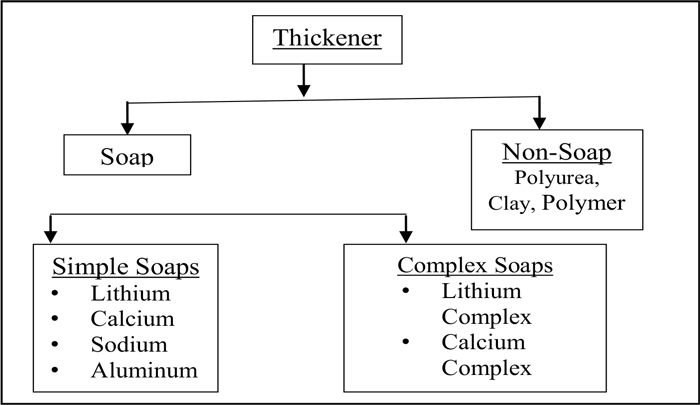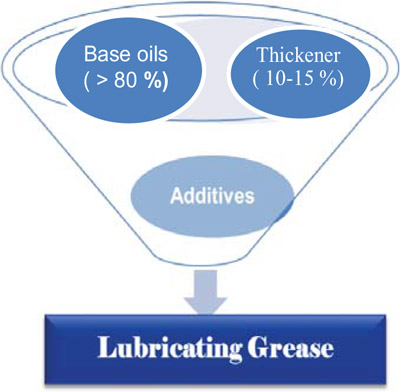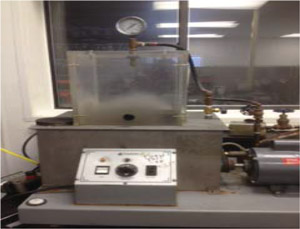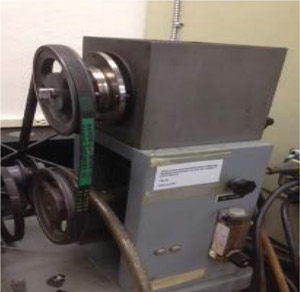How to Select Right Lubricating Grease For Your Application?
In this technological savvy world, newer products and technologies are emerging at much faster pace than we actually think and lubricating greases are not far behind. In last few decades, great deal of technological advancement has taken place in the feld of lubricating greases and tons of new products can be seen in the market. There have been ever increasing trend to market more and more customized products suiting a specifc customer requirements in industries like steel, cement, automotive, off highway, chemical, oil & gas, food processing, mining, marine, agricultural etc. On the other hand, the knowledge of end use customer is limited and decision about what type of grease to be used, is mainly governed by supplier’s recommendation which sometime may be biased and possibly misleading. This article is focused around the concept of what one should know about lubricating greases so that end use customer could be smart enough to select right product for right application.
Lubricating Greases
 The idea of using lubricant to reduce friction and wear was perhaps known to the mankind since ancient times perhaps concomitantly with the discovery of wheel. Records indicate that the frst lubricant ever used by mankind was probably water in around 3500 BC by Chinese followed by use of animal fat or olive oil mixed with lime, a kind of crude lubricating grease, in 1400 BC by Egyptians in their Chariots. Since then, technologies have progressed remarkably, especially in last 200 years, the developments in feld of lubricating greases has been much slower and less scientifc. It has been reported that until close to 1800, the universal lubricants were beef / mutton tallow or a vegetable oil. This drilling of frst petroleum crude by Colonel Drake in 1859 had revolutionized the entire industry where most of the lubricants were virtually replaced by mineral oil based products. Since then phenomenal progress has been achieved and countless developments have taken place in the feld of lubricants and greases and as a result, a large number of products are available in the market. This sometime confuses the end user and poses challenge in terms of selecting right product for their application.
The idea of using lubricant to reduce friction and wear was perhaps known to the mankind since ancient times perhaps concomitantly with the discovery of wheel. Records indicate that the frst lubricant ever used by mankind was probably water in around 3500 BC by Chinese followed by use of animal fat or olive oil mixed with lime, a kind of crude lubricating grease, in 1400 BC by Egyptians in their Chariots. Since then, technologies have progressed remarkably, especially in last 200 years, the developments in feld of lubricating greases has been much slower and less scientifc. It has been reported that until close to 1800, the universal lubricants were beef / mutton tallow or a vegetable oil. This drilling of frst petroleum crude by Colonel Drake in 1859 had revolutionized the entire industry where most of the lubricants were virtually replaced by mineral oil based products. Since then phenomenal progress has been achieved and countless developments have taken place in the feld of lubricants and greases and as a result, a large number of products are available in the market. This sometime confuses the end user and poses challenge in terms of selecting right product for their application.
National Lubricating Grease Institute (NLGI), USA worldwide grease market survey indicates about 2.4 billion lbs of total worldwide grease volume, where mineral oil based greases have dominated by about 92% followed by synthetic and semi-synthetic oil based greases totaling about 7%. Bio-based greases found their entry for the frst time in 2010 survey, has now about meager 1 % market share. These greases are being marketed both in auto and industrial applications.
Lubrication: Oil or Greases?
In general, lubrication can either be achieved by lubricating oil (fluid) or grease (semi-solid). Now question arises when to use lubricating oil and where to use lubricating greases? Though there are different school of thoughts, however, there is some applications where lubrication by grease is preferred due to following reasons:
| DmN Factor | Viscosity at 40•C |
|---|---|
| <100,000 | 460 |
| 100,000 | 220 |
| 300,000 | 150 |
| 500,000 | 100 |
| 600,000 | 68 |
- Lubricating greases acts as sealant preventing ingress of extraneous particles and water
- Stays better on application and due to leak out and minimizes the chances of dry start
- Easy to mix with solid lubricants like moly, graphite and other solid lubricants
- > 90 % roller bearings are grease lubricated
In general, a particular application whether to use lubricating oil or lubricating greases is generally governed by its DmN factor which can be calculated as follows
- DmN factor = N x (D + d) /2
- D= Bearing outer diameter, mm, d=Bearing bore diameter, mm
- N=Bearing operating speed, rpm. If DmN factor is more than as shown below oil should be used.
Lubricating greases are generally recommended up to 1 million DmN factor baring few exceptions. For lower DmN factor ranging from 100,000 to 500,000 mineral oil based greases with suitable viscosity may be used however, for higher DmN factor synthetic oil based greases are preferred. DmN factor beyond this, oil lubrication is recommended.
What are Lubricating Greases?
 As ASTM (American Society of Testing Materials) defnes grease as “a solid to semi-fluid product of the dispersion of a thickening agent in a liquid lubricant”. The thickener provides it non-Newtonian nature by the dispersion of base oil in its gel like structure and acts like sponge. Lubricating greases basically consist of base oil (75-85%), thickener (10-15%) and performance additives (Figure- 1&2). Both base oils as well as thickeners influence properties of lubricating greases. Performance additives are added to boost the certain desired performance label of lubricating greases. For examples, extreme pressure (EP) additives are added to boost EP characteristics of particular grease and anti-oxidants are added to control thermal degradation of oil.
As ASTM (American Society of Testing Materials) defnes grease as “a solid to semi-fluid product of the dispersion of a thickening agent in a liquid lubricant”. The thickener provides it non-Newtonian nature by the dispersion of base oil in its gel like structure and acts like sponge. Lubricating greases basically consist of base oil (75-85%), thickener (10-15%) and performance additives (Figure- 1&2). Both base oils as well as thickeners influence properties of lubricating greases. Performance additives are added to boost the certain desired performance label of lubricating greases. For examples, extreme pressure (EP) additives are added to boost EP characteristics of particular grease and anti-oxidants are added to control thermal degradation of oil.
The ability of lubricating grease to perform in a particular application depends on its physico-chemical and performance characteristics which are generally measured by standard ASTM /IP/DIN etc. methods as described below.
What Does Base Oil Do in Lubricating Greases?
Base oils in lubricating greases are present in majority (> 80 %) and main function of lubrication is taken care by base oil, thickeners acts as carrier of oil and act like sponge where it releases oil at point of application. Base oils influence pumping and flow-ability of lubricating greases. High viscosity oil based greases flow / pump slowly compared to low viscosity oil based greases. This is the reason, where ever application speeds are low and bearing diameters are comparatively large, high viscosity oil based greases (e.g., VG 460) are preferred. On the other hand, in applications where bearing run under high speed, low viscosity oil based greases (VG 32 –VG 68 ) oil based greases may be recommended. Base oil also greatly influences the low temperature characteristics of greases; mineral oil based greases are generally recommended up to -18 °C with appropriate viscosity adjustment. The choice of a viscosity depend on intended service, for higher DmN factor, low viscosity is preferred while for higher loads and low DmN factor heavier oils are more suitable.
What Does Thickener Do in Lubricating Greases?
Thickeners on the other hand, are considered backbone of the greases. The thickener system may be a simple metal soap, a complex soap, a synthetic organic thickener, or inorganic gelling agents. Whatever the thickener type be, many of the important properties and performance characteristics of the fully formulated grease comes from the actual thickener system. High temperature capabilities of grease are function of thickener though base oil does play some role. Water resistance characteristics of grease are also controlled by type of thickener, like soda base greases are poor in water resistance whereas aluminum complex and sulfonate base greases are known for its superior water resistance properties.
| Consistency | the extent to which the grease resist deformation under the influence of force |
| Shear Stability | the ability of the grease to resist changes in consistency during mechanical shearing |
| Oxidation Stability | the ability of the grease to resist chemical deterioration |
| High Temp. Stability | the ability of the grease to retain consistency at elevated temperatures |
| Water Resistance | the ability of the grease to withstand against water ingress |
| Rust/Corrosion Resistance | the ability of the grease to protect metal surfaces against rust and corrosion |
What Does Additives Do in Lubricating Greases?
An additive is any material added to a lubricating oil or grease formulation to improve that product’s ability to perform the task called for. In fully formulated grease, the base oil imparts certain characteristics and thickeners also bring certain characteristics to the formulation. The additives doped in the formulation may either add to these characteristics, or may boost desired characteristics already present. These pressure properties, corrosion and rust inhibition, water resistance, low temperature fluidity, color, and odor etc.
| Lithium soap with suitable oilviscosity and additives | Operating temperature up to + 120 °C max | • Multi purpose • Automotive chassis and wheel bearings • Non-critical Industrial |
| Li-complex soap with suitable oil – viscosity and additives | Operating temperature up to +150 °C max | • High temperatures • High pressure and shock load |
| Aluminum complex soap with suitable oil – viscosity and additives | Operating temperature up to 150 °C max | • Heavy water environments • High temperatures • Food processing and pharma industry • Mining, fertilizers, petrochemicals operations |
| Poly urea with suitable oil-viscosity and additives | Operating temperature up to +180°C max | • High Temperatures • Oven, conveyor bearings • Electric motors • Refining and petrochemicals • Foundry, metal processing |
| Clay | Operating temperature up to 150 °C | • High temperatures • Food processing |
| Sulfonate Greases with suitable oil viscosity and additives | Operating temperature up to 180 °C | • Water prone • Mining and Marine • Oil & gas • drilling and refining |
Lubricating Greases: General Recommendations
The application recommendations of a grease depends on the properties of a particular grease which are influenced by type of thickener, base oil present in it and also on the additives. For example lithium grease can be recommended up to + 120°C operating temperatures. Different greases, their operating temperatures formulated in different oils and their general applications are indicated as follows (Table-1 and Table-2).
| Environment | Industry | Recommendation |
|---|---|---|
| Moderate Load, Temp (-18°C to+120°C), High Speed, less water ingress | Agriculture, Farm, Truck & Auto WB, General purpose | Lithium EP (VG 150-220 oil; NLGI 2) |
| Heavy Load, Temp (-18°C to + 150°C), Moderate Speed, some water ingress | Agriculture, mining Construction, Farm, Truck & Auto (NLGI GC-LB), Heavy Duty | Lith. Complex EP (VG 150-220 oil; NLGI 2) |
| Extreme Load, Temp (-18°C to + 150°C), Low Speed, humid and Dusty Environment | Oil & gas, drilling, fertilizer plants, agriculture / Farm, Off Highway, Mining, Heavy Industry | Lithium Complex EP Greases (VG 460 ; NLGI 2) or Sulfonate Complex |
| High Speed, Moderate Load, Temp (- 40 °C to + 180°C ), Moderate water | Agriculture / Farm, Off Highway, Mining, Heavy Industry, petrochemicals | Synthetic Greases (Lithium Complex, Polyurea, Sulfonate Complex) |
| Incidental Food Contact, Hot & Cold Temp, High speeds, Moderate loads | Food & Beverage Industry And pharmaceuticals | H1 Food Grade Greases (Aluminum Complex |
How to Read / Analyse Product Data Sheet
 In general one grease can be used for more than one application in the industry and therefore product data sheet of particular grease contain many test. For end users, one need to know what tests are relevant to them, as all the tests listed in the tested may not be as relevant as other. For example for a high temperature application where chances of water ingress are not there, water resistant properties may not be critical. Similarly for application temperature below 100°C, you may not need high temperature grease. Therefore its important to understand your application requirement and then you need to select the appropriate grease for your application. Following are general recommendations for understanding and analyzing the supplier data sheet.
In general one grease can be used for more than one application in the industry and therefore product data sheet of particular grease contain many test. For end users, one need to know what tests are relevant to them, as all the tests listed in the tested may not be as relevant as other. For example for a high temperature application where chances of water ingress are not there, water resistant properties may not be critical. Similarly for application temperature below 100°C, you may not need high temperature grease. Therefore its important to understand your application requirement and then you need to select the appropriate grease for your application. Following are general recommendations for understanding and analyzing the supplier data sheet.
Water Resistance
 Water resistance properties of grease are measured by following tests i) Water washout test ( ASTM D 1264) ( Figure 3) ii) Water spray off test ( ASTM D 4049) ( Figure 4) iii) Mechanical / Roll stability in presence of water ( ASTM D 217 / D 1831)
Water resistance properties of grease are measured by following tests i) Water washout test ( ASTM D 1264) ( Figure 3) ii) Water spray off test ( ASTM D 4049) ( Figure 4) iii) Mechanical / Roll stability in presence of water ( ASTM D 217 / D 1831)
Water washout test is more relevant in applications where chances of little water contact or humidity are there. If water is coming direct in contact with grease and with pressure, water spray off test is more relevant as in this test. In conditions where water may get mixed with grease and stability of grease in presence of water may be important, either mechanical or roll stability with 10 / 50 % water. Following table indicate the normal expected limits of these tests.
Extreme Pressure Properties
Extreme pressures are generally encountered in off high way, mining operations, steel mills, cement / concrete manufacturing etc. Some extreme pressure (EP) properties are provided by thickeners, like sulfonate thickeners possesses inherent EP characteristics however, by and large EP additives are added to meet desired extreme pressure properties. These properties are generally measured by following two tests Table-2: Application Conditions and Grease Recommendations Table-3: Evaluating Water Resistant Properties Figure 3 : Water Washout Apparatus Figure 4 : Water Spray off Apparatus i) Four Ball Weld Load (ASTM D 2596) ii) Timken, OK Load (ASTM D 2509). For normal EP requirement weld load of 250 kg and over is considered adequate. Similarly Timken OK load of about 45 lbs is sufficient. For heavy duty operations like off high and mining equipment and rolling operations in steel, heavy duty greases with four ball weld load over 400 kg and Timken OK load of 60 lbs might be required. Some other test data requirement and general recommendations are depicted in table 4. These recommendations, though not any set rule, are however based on experience based on trial and product applications.
| # | Test | Conditions | limits | Remark |
|---|---|---|---|---|
| 1. | Water washout, % wt. washed (ASTM D 1264) | 1750F, 1 Hrs | < 5.0 % 5.0-15.0% >15.0 % |
Excellent Good Average/poor |
| 2. | Water spray off, % wt. washed (ASTM D 4049) | 10 min, 40 PSI | < 10 % 10-20 % 20-30 % 30-50 >50 % |
Outstanding Very Good Good Okay/average Poor |
| 3. | Mechanical/Roll Stability, w/10% water (ASTM D 217/1831) | 10,000 strokes | <10% 10-20% >20% |
Excellent Good Average/Poor |
Do Not Drip Properties
Stability of grease in application area is an important requirement as if grease do not stay or leak from application, may lead to premature failure of bearings. This property can be tested by studying mechanical, roll stability and leakage tendency tests. If change in penetration after 1 lac strokes is < 30 units, grease is considered very stable. similarly, if roll stability is < 10 % and leakage is < 6 gm tested as per method, grease is likely to be stable in the bearing.
High Temperature Capabilities
High temperature capabilities of a grease can be indicatively judged by drop point, PDSC, high temperature life by ASTM D 3527 / 3336 and/or FE methods. If the drop point of grease is in the range of 180 C, the application temperatures to could be in the range of 120 C and if the drop point of the grease is around 260 C or more then grease could work at high temperature, however how much will depend on other application factors as well. Life of grease over 80 hrs. as per ASTM D 3527, the grease is considered having good high temperature life (table-4). There are some other methods like FE and PDSC that also gives good indication of high temperature capabilities of greases.
In summary, it is essential to understand your application requirements and then selection of grease depends on your logical and judicious decision as more than one product might be suitable for your application. While making change over from type of product to other, its important to ensure the compatibility of existing grease with new grease.
| Property | Test Property | Data | Remark |
|---|---|---|---|
| Stability/Strength | Pen after 100,000 strokes | < 30 | Will not leak during storage/running |
| Roll Stability | < 10 % | ||
| Leakage Tendency | < 6 gm | ||
| High Temp. Property | Drop Point, 0C | < 180 | Multi-purpose |
| > 260 | High Temperature | ||
| High Temperature Life, @ 160 C, hrs. | >80 | Good High Temperature life | |
| Heavy Load Capabilities' | Weld Point & Timken | 250 kg, 45 lbs | High Load-on road |
| >400 kg, 60 lbs | Heavy Duty - off highway, mining |
About the Author
Anoop Kumar, Ph.D. in Chemistry from Indian Institute of Technology, Roorkee, India, is Director of R&D and Business Development at Royal Mfg Co LP. He has over 25 years of experience in formulation, manufacturing and market development of lubricating greases and industrial oils. Dr Kumar has published / presented over 80 technical papers on lubricants and has authored over 25 patents worldwide. Over the years, he has several awards to his credit and currently representing serval technical societies and committees. He played a crucial role in formation of NLGI India Chapter and currently serves in Executive Committee as Treasurer of NLGI.
